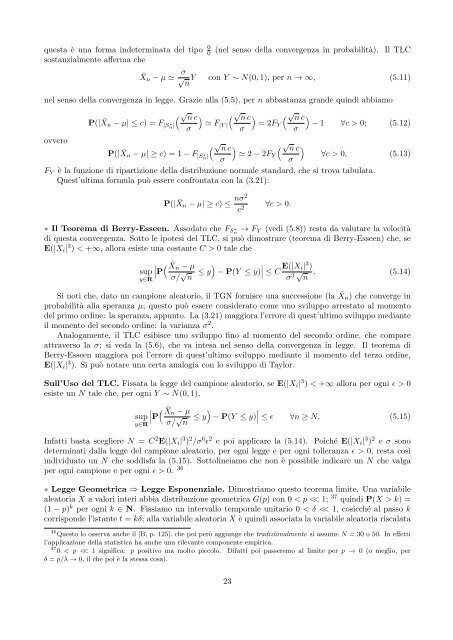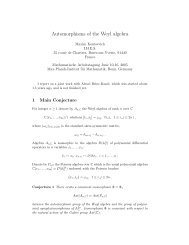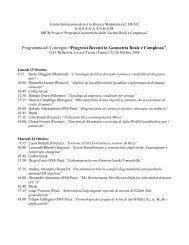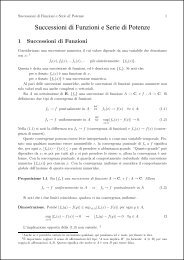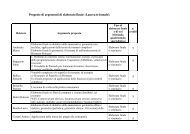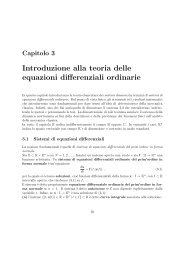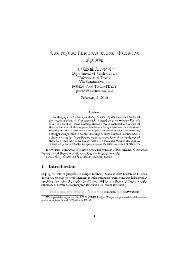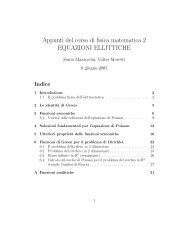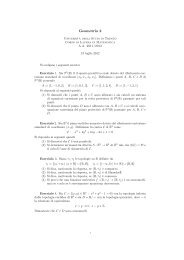Note del corso di Analisi II (parte di calcolo delle probabilita' e ...
Note del corso di Analisi II (parte di calcolo delle probabilita' e ...
Note del corso di Analisi II (parte di calcolo delle probabilita' e ...
You also want an ePaper? Increase the reach of your titles
YUMPU automatically turns print PDFs into web optimized ePapers that Google loves.
questa è una forma indeterminata <strong>del</strong> tipo 0 0<br />
(nel senso <strong>del</strong>la convergenza in probabilità). Il TLC<br />
sostanzialmente afferma che<br />
¯X n − µ ≃ √ σ Y con Y ∼ N(0, 1), per n → ∞, (5.11)<br />
n<br />
nel senso <strong>del</strong>la convergenza in legge. Grazie alla (5.5), per n abbastanza grande quin<strong>di</strong> abbiamo<br />
P(| ¯X n − µ| ≤ c) = F |S ∗ n |<br />
( √ n c<br />
σ<br />
)<br />
≃ F |Y |<br />
( √ n c<br />
σ<br />
) ( √ n c)<br />
= 2F Y − 1 ∀c > 0; (5.12)<br />
σ<br />
ovvero<br />
P(| ¯X<br />
( √ n c) ( √ n c)<br />
n − µ| ≥ c) = 1 − F |S ∗ n | ≃ 2 − 2F Y ∀c > 0, (5.13)<br />
σ<br />
σ<br />
F Y è la funzione <strong>di</strong> ripartizione <strong>del</strong>la <strong>di</strong>stribuzione normale standard, che si trova tabulata.<br />
Quest’ultima formula può essere confrontata con la (3.21):<br />
P(| ¯X n − µ| ≥ c) ≤ nσ2<br />
c 2 ∀c > 0.<br />
∗ Il Teorema <strong>di</strong> Berry-Esseen. Assodato che F S ∗ n<br />
→ F Y (ve<strong>di</strong> (5.8)) resta da valutare la velocità<br />
<strong>di</strong> questa convergenza. Sotto le ipotesi <strong>del</strong> TLC, si può <strong>di</strong>mostrare (teorema <strong>di</strong> Berry-Esseen) che, se<br />
E(|X i | 3 ) < +∞, allora esiste una costante C > 0 tale che<br />
(<br />
∣<br />
¯Xn − µ )<br />
sup ∣P<br />
σ/ √ n ≤ y − P(Y ≤ y) ∣ ≤ C E(|X i| 3 )<br />
σ 3 √ n . (5.14)<br />
y∈R<br />
Si noti che, dato un campione aleatorio, il TGN fornisce una successione (la ¯X n ) che converge in<br />
probabilità alla speranza µ; questo può essere considerato come uno sviluppo arrestato al momento<br />
<strong>del</strong> primo or<strong>di</strong>ne: la speranza, appunto. La (3.21) maggiora l’errore <strong>di</strong> quest’ultimo sviluppo me<strong>di</strong>ante<br />
il momento <strong>del</strong> secondo or<strong>di</strong>ne: la varianza σ 2 .<br />
Analogamente, il TLC esibisce uno sviluppo fino al momento <strong>del</strong> secondo or<strong>di</strong>ne, che compare<br />
attraverso la σ; si veda la (5.6), che va intesa nel senso <strong>del</strong>la convergenza in legge. Il teorema <strong>di</strong><br />
Berry-Esseen maggiora poi l’errore <strong>di</strong> quest’ultimo sviluppo me<strong>di</strong>ante il momento <strong>del</strong> terzo or<strong>di</strong>ne,<br />
E(|X i | 3 ). Si può notare una certa analogia con lo sviluppo <strong>di</strong> Taylor.<br />
Sull’Uso <strong>del</strong> TLC. Fissata la legge <strong>del</strong> campione aleatorio, se E(|X i | 3 ) < +∞ allora per ogni ɛ > 0<br />
esiste un N tale che, per ogni Y ∼ N(0, 1),<br />
(<br />
∣<br />
¯Xn − µ )<br />
sup ∣P<br />
σ/ √ n ≤ y − P(Y ≤ y) ∣ ≤ ɛ ∀n ≥ N. (5.15)<br />
y∈R<br />
Infatti basta scegliere N = C 2 E(|X i | 3 ) 2 /σ 6 ɛ 2 e poi applicare la (5.14). Poiché E(|X i | 3 ) 2 e σ sono<br />
determinati dalla legge <strong>del</strong> campione aleatorio, per ogni legge e per ogni tolleranza ɛ > 0, resta così<br />
in<strong>di</strong>viduato un N che sod<strong>di</strong>sfa la (5.15). Sottolineiamo che non è possibile in<strong>di</strong>care un N che valga<br />
per ogni campione e per ogni ɛ > 0. 36<br />
∗ Legge Geometrica ⇒ Legge Esponenziale. Dimostriamo questo teorema limite. Una variabile<br />
aleatoria X a valori interi abbia <strong>di</strong>stribuzione geometrica G(p) con 0 < p k) =<br />
(1 − p) k per ogni k ∈ N. Fissiamo un intervallo temporale unitario 0 < δ


